Yamaha CDX-470 Owner Manual
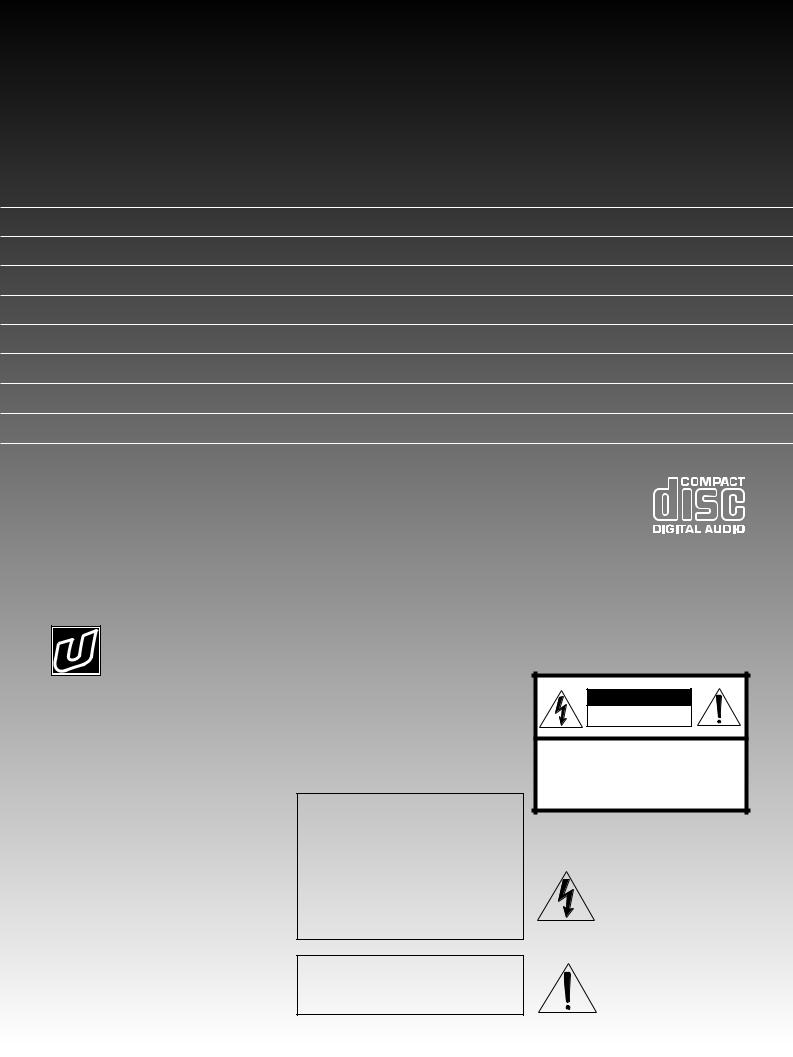





 CDX-470
CDX-470
Natural Sound Compact Disc Player
Random Access Programmable Play
Random-Sequence Play
Single Track/Entire Disc Repeat Play
Automatic Tape-Programming
Automatic Peak Level Searching Capability
Display Brightness Changing Capability
Remote Control Capability
Thank you for selecting this YAMAHA Compact Disc Player.
OWNER’S MANUAL |
|
CONTENTS |
|
Safety Instructions.................... |
2 |
Connections ............................. |
4 |
Identification of Components.... |
5 |
Loading the Disc/Disc Play....... |
6 |
Random-Sequence Play .......... |
9 |
Repeat Play.............................. |
9 |
Program Play.......................... |
10 |
Index Search .......................... |
11 |
Track Programming for |
|
Recording to Tape ................. |
12 |
Notes about the Remote |
|
Control Transmitter ................. |
16 |
Notes about Handling |
|
Compact Discs ....................... |
16 |
Troubleshooting ...................... |
17 |
Specifications ......................... |
17 |
IMPORTANT!
Please record the serial number of this unit in the space below.
Model:
Serial No.:
The serial number is located on the rear of the unit.
Retain this Owner’s Manual in a safe
place for future reference.
WARNING
TO REDUCE THE RISK OF FIRE OR ELECTRIC SHOCK, DO NOT EXPOSE
THIS UNIT TO RAIN OR MOISTURE.
CAUTION
RISK OF ELECTRIC SHOCK
DO NOT OPEN
CAUTION: TO REDUCE THE RISK OF
ELECTRIC SHOCK, DO NOT REMOVE
COVER (OR BACK), NO USER-SERVICEABLE
PARTS INSIDE, REFER SERVICING TO
QUALIFIED SERVICE PERSONNEL.
• Explanation of Graphical Symbols
The lightning flash with arrowhead symbol, within an equilateral triangle,
is intended to alert you to the presence of uninsulated “dangerous voltage” within the product’s enclosure that may be of sufficient
magnitude to constitute a risk of electric shock to persons.
The exclamation point within an equilateral triangle is intended to alert
you to the presence of important operating and maintenance (servicing) instructions in the
literature accompanying the
appliance.

SAFETY INSTRUCTIONS
1Read Instructions – All the safety and operating instructions should be read before the unit is operated.
2Retain Instructions – The safety and operating instructions should be retained for future reference.
3Heed Warnings – All warnings on the unit and in the operating instructions should be adhered to.
4Follow Instructions – All operating and other instructions should be followed.
5Water and Moisture – The unit should not be used near water – for example, near a bathtub, washbowl, kitchen sink, laundry tub, in a wet basement, or near a swimming pool, etc.
6Carts and Stands – The unit should be used only with a cart or stand that is recommended by the manufacturer.
6A A unit and cart combination should be moved with care. Quick stops, excessive force, and uneven surfaces may cause the unit and cart combination to overturn.
7Wall or Ceiling Mounting – The unit should be mounted to a wall or ceiling only as recommended by the manufacturer.
8Ventilation – The unit should be situated so that its location or position does not interfere with its proper ventilation. For example, the unit should not be situated on a bed, sofa, rug, or similar surface, that may block the ventilation openings; or placed in a built-in installation, such as a bookcase or cabinet that may impede the flow of air through the ventilation openings.
9Heat – The unit should be situated away from heat sources such as radiators, stoves, or other appliances that produce heat.
10Power Sources – The unit should be connected to a power supply only of the type described in the operating instructions or as marked on the unit.
11Power-Cord Protection – Power-supply cords should be routed so that they are not likely to be walked on or pinched by items placed upon or against them, paying particular attention to cords at plugs, convenience receptacles, and the point where they exit from the unit.
12Cleaning – The unit should be cleaned only as recommended by the manufacturer.
13Nonuse Periods – The power cord of the unit should be unplugged from the outlet when left unused for a long period of time.
14Object and Liquid Entry – Care should be taken so that objects do not fall into and liquids are not spilled into the inside of the unit.
15Damage Requiring Service – The unit should be serviced by qualified service personnel when:
A.The power-supply cord or the plug has been damaged; or
B.Objects have fallen, or liquid has been spilled into the unit; or
C.The unit has been exposed to rain; or
D.The unit does not appear to operate normally or exhibits a marked change in performance; or
E.The unit has been dropped, or the cabinet damaged.
16Servicing – The user should not attempt to service the unit beyond those means described in the operating instructions. All other servicing should be referred to qualified service personnel.
17Power Lines – An outdoor antenna should be located away from power lines.
18Grounding or Polarization – Precautions should be taken so that the grounding or polarization is not defeated.
CAUTION: READ THIS BEFORE OPERATING YOUR UNIT
1To ensure the finest performance, please read this manual carefully. Keep it in a safe place for future reference.
2Install your unit in a cool, dry, clean place – away from windows, heat sources, and too much vibration, dust, moisture or cold. Avoid sources of hum (transformers, motors). To prevent fire or electrical shock, do not expose to rain and water.
3Do not operate the unit upside-down. It may overheat, possibly causing damage.
4Never open the cabinet. If a foreign object drops into the set, contact your dealer.
5Do not use force on switches, knobs or cords. When moving the set, first turn the unit off. Then gently disconnect the power plug and the cords connecting to other equipment. Never pull the cord itself.
6Do not attempt to clean the unit with chemical solvents; this might damage the finish. Use a clean, dry cloth.
7Be sure to read the “TROUBLESHOOTING” section on common operating errors before concluding that your unit is faulty.
2
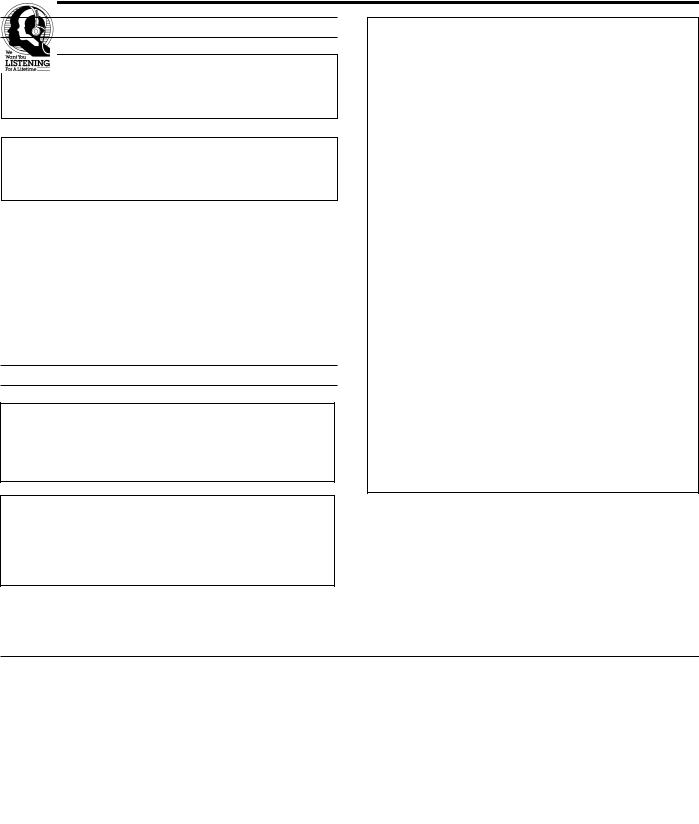
WARNING
CAUTION
Use of controls or adjustments or performance of procedures other than those specified herein may result in hazardous radiation exposure.
DANGER
Invisible laser radiation when open and interlock failed or defeated.
Avoid direct exposure to beam.
As the laser beam used in this compact disc player is harmful to the eyes, do not attempt to disassemble the cabinet. Refer servicing to qualified personel only.
To avoid electrical shock, do not open the unit. Refer servicing to qualified personnel only.
DANGER: The use of optical instrument with this product will increase eye hazard.
FCC INFORMATION
1IMPORTANT NOTICE : DO NOT MODIFY THIS UNIT!
This product, when installed as indicated in the instructions contained in this manual, meets FCC requirements. Modifications not expressly approved by Yamaha may void your authority, granted by the FCC, to use the product.
2.IMPORTANT : When connecting this product to accessories and/or another product use only high quality shielded cables. Cable/s supplied with this product MUST be used. Follow all installation instructions. Failure to follow instructions could void your FCC authorization to use this product in the USA.
3.NOTE : This product has been tested and found to comply with the requirements listed in FCC Regulations, Part 15 for Class “B” digital devices. Compliance with these requirements provides a reasonable level of assurance that your use of this product in a residential environment will not result in harmful interference with other electronic devices.
This equipment generates/uses radio frequencies and, if not installed and used according to the instructions found in the users manual, may cause interference harmful to the operation of other electronic devices. Compliance with FCC regulations does not guarantee that interference will not occur in all installations. If this product is found to be the source of interference, which can be determined by turning the unit “OFF” and “ON”, please try to eliminate the problem by using one of the following measures:
Relocate either this product or the device that is being affected by the interference.
Utilize power outlets that are on different branch (circuit breaker or fuse) circuits or install AC line filter/s.
In the case of radio or TV interference, relocate/reorient the antenna. If the antenna lead-in is 300 ohm ribbon lead, change the lead-in to coaxial type cable.
If these corrective measures do not produce satisfactory results, please contact the local retailer authorized to distribute this type of product. If you can not locate the appropriate retailer, please contact Yamaha Electronics Corp., U.S.A. 6660 Orangethorpe Ave, Buena Park, CA 90620.
The above statements apply ONLY to those products distributed by Yamaha Corporation of America or its subsidiaries.
We Want You Listening For A Lifetime
YAMAHA and the Electronic Industries Association’s Consumer Electronics Group want you to get the most out of your equipment by playing it at a safe level.
One that lets the sound come through loud and clear without annoying blaring or distortion – and, most importantly, without affecting your sensitive hearing. Since hearing
damage from loud sounds is often undetectable until it is too late, YAMAHA and the Electronic Industries Association’s Consumer Electronics Group recommend you to avoid prolonged exposure from excessive volume levels.
3
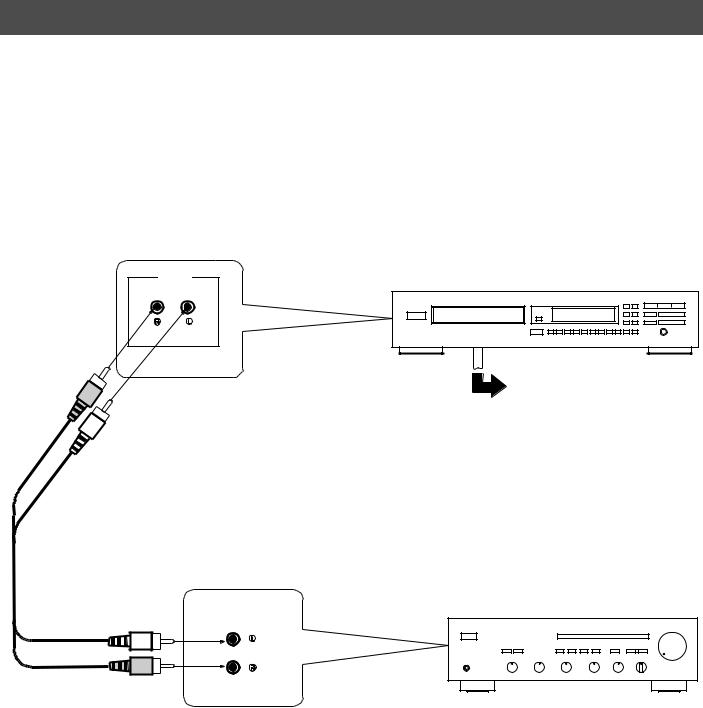
CONNECTIONS
•Before making any connections, switch OFF the power to the unit and the amplifier or other component.
•Connect the “LINE OUT” terminals to the “CD” (or “AUX”) terminals of the amplifier. If the amplifier does not have such terminals, use the “TAPE PB” terminals. For additional details concerning these connections, refer to the operation instructions for the amplifier being used.
•Be sure that the left (“L”) and right (“R”) LINE OUT terminals are connected to the corresponding (left and right) terminals of the amplifier or other component.
•If the placement of this unit causes noise to other equipment, such as a tuner, separate them from each other.
LINE OUT |
This unit |
To AC outlet
Connection cord (included)
Amplifier
CD
4
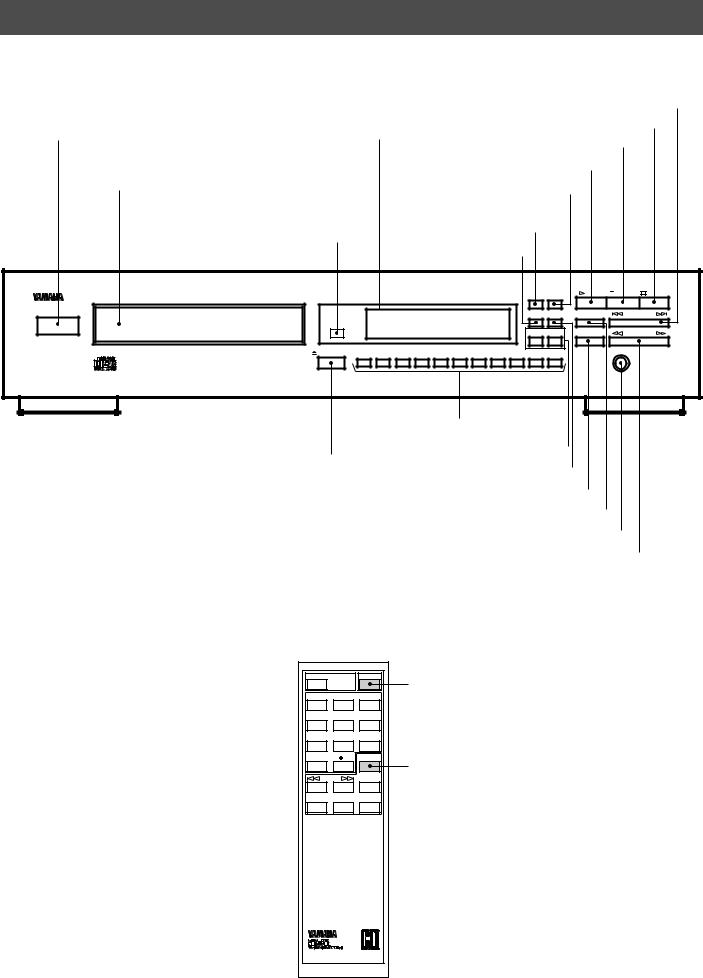
IDENTIFICATION OF COMPONENTS
FRONT PANEL
SKIP button
STOP button
POWER switch Display panel
PAUSE button
PLAY button
Disc tray |
PEAK button |
|
|
|
TIME display |
|
modeselect button |
|
Remote control sensor |
|
TAPE button |
NATURAL SOUND COMPACT DISC PLAYER |
|
|
|
|
|
|
|
|
|
TIME |
PEAK |
PLAY |
PAUSE |
STOP |
|
|
|
|
|
|
|
|
|
|
|
|
|||
|
|
|
|
|
|
|
|
|
|
|
|
|
|
|
POWER |
|
|
|
|
|
|
|
|
|
TAPE |
PROG |
RANDOM |
SKIP |
|
|
|
|
|
|
|
|
|
|
|
|
||||
|
|
|
|
|
|
|
|
|
|
OUTPUT LEVEL |
REPEAT |
SEARCH |
||
|
|
|
|
|
|
|
|
|
|
DOWN |
UP |
|||
OPEN/CLOSE |
+10 |
1 |
2 |
3 |
4 |
5 |
6 |
7 |
8 |
9 |
0 |
|
|
|
|
|
|
|
|
|
|
|
|
|
|
|
PHONES |
|
|
Numeric buttons
OUTPUT LEVEL buttons
OPEN/CLOSE button
PROG button
REPEAT button
RANDOM button
PHONES jak
SEARCH button
REMOTE CONTROL TRANSMITTER
*The control functions on the main unit and on the remote control transmitter are virtually identical, with the exceptions below.
|
OPEN/ |
MODE |
|
|
|
|
CLOSE |
|
1 |
2 |
3 |
4 |
5 |
6 |
7 |
8 |
9 |
0 |
10 |
INDEX |
|
SKIP |
PLAY |
OUTPUT LEVEL |
STOP |
|
DOWN |
UP |
|
MODE button
INDEX button
5
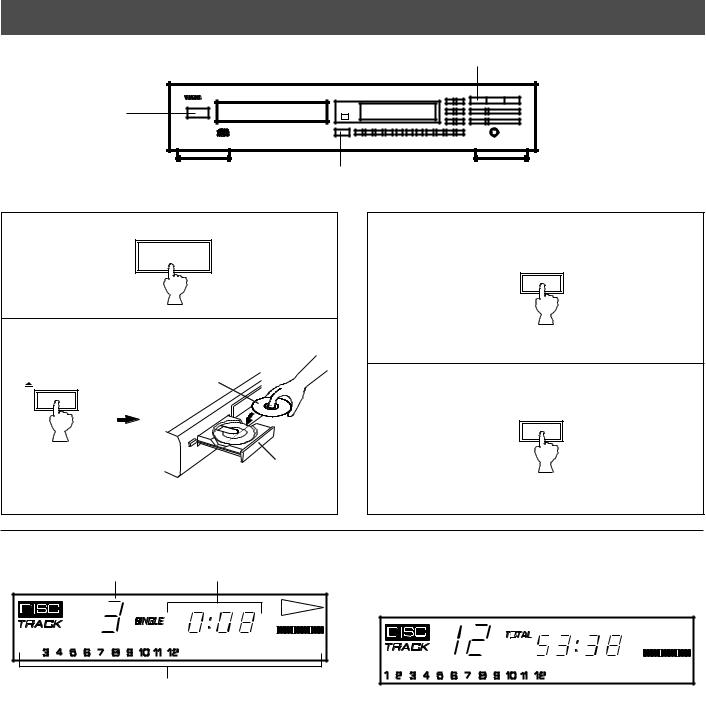
LOADING THE DISC/DISC PLAY
4
1 |
2, 3 |
1 |
POWER |
|
|
2 |
|
|
Label side |
|
upward |
|
OPEN/CLOSE |
|
Disc tray |
3
 OPEN/CLOSE
OPEN/CLOSE
4
 PLAY
PLAY
Shows the time displays. (Refer to “Selecting time displays” on page 8.)
Displays the numbers that correspond to the numbers of tracks (as high as number 20) on the disc. After each track is played, its corresponding number disappears so the number of remaining tracks (and their numbers) can be seen at a glance.
close the disc tray by pressing the PLAY button, a numeric button or the RANDOM button, or by pressing the front edge of the disc tray gently. If the tray is closed in these ways, play will begin automatically, however, the display will not show the total number of tracks and the total recorded time of the disc.
6
